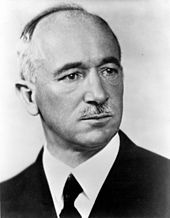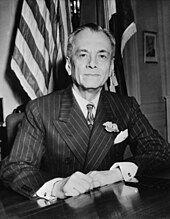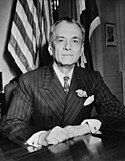Alliés de la Seconde Guerre mondiale
Pour les articles homonymes, voir Alliés (homonymie) et Trois Grands.
Les Alliés de la Seconde Guerre mondiale sont l’ensemble des pays qui s’opposèrent formellement aux forces de l’Axe durant la Seconde Guerre mondiale. Lors de la phase finale du conflit, à partir de , ces pays étaient souvent désignés du nom de Nations unies, mais aujourd’hui ce nom se réfère à l’Organisation des Nations unies qu’ils fondèrent après la guerre. Parmi les rangs des forces alliées on comptait : les États-Unis, forte puissance utile du fait de ses nombreux hommes dans leur armée, l’Union soviétique et le Royaume-Uni, désignés sous le nom collectif de « Trois Grands »[1]. Le président Franklin D. Roosevelt, se référant aux Trois Grands plus la Chine, parlait des « Quatre gendarmes »[2]. Le général de Gaulle parvint, par une diplomatie habile et par la participation de la France libre à l'effort de guerre, à intégrer la France parmi les signataires des actes de capitulation du Troisième Reich le 8 mai 1945, puissances occupantes de l'Allemagne vaincue, et membres du tribunal de Nuremberg.
Toutefois leur participation fut chronologiquement décalée : la France cesse le combat après la défaite de juin 1940 et adopte un régime officiellement neutre, mais collaborant en fait avec l’Axe, ce que les Britanniques considèrent comme une trahison car les deux Alliés s’étaient engagés le à ne pas conclure d’armistice séparé au nom du « bien de la justice et de la liberté » (for the sake of morale & freedom)[3] : le général de Gaulle partage ce point de vue[4] mais ne sera reconnu comme chef légitime de la France qu’en 1944 ; l’URSS ne fait partie des Alliés qu’à partir du , date de l’attaque allemande de l’URSS : avant cette date, depuis le , l’URSS, officiellement neutre, était en fait liée à l’Allemagne nazie par le Pacte germano-soviétique et avait envahi l’Est de la Pologne à partir de mi-septembre 1939, prenant à revers les troupes polonaises en lutte contre l’armée allemande ; enfin les États-Unis n’entrent officiellement en guerre qu’après l’attaque de Pearl Harbor, en décembre 1941 ; néanmoins, avant cette date, ils apportent une aide importante à leurs alliés « officieux » sous forme matérielle, notamment par les convois d’approvisionnement de la Grande-Bretagne par l’Atlantique nord.
Dates auxquelles les États indépendants et leurs dépendances ont rejoint les Alliés

- Puissances de l'Axe
- Colonies et territoires occupés de l'Axe
- Alliés occidentaux
- Dominions des Alliés occidentaux
- Colonies et territoires occupés des Alliés occidentaux
- Alliés de l'Est (URSS et États satellites)
- Empire du Japon et États satellites (avant de rejoindre l'Axe)
- URSS et États satellites (avant de rejoindre les Alliés)
- France de Vichy et ses colonies (neutre, mais collaboratrice de l'Axe)
- Autres pays neutres
Après l’invasion de la partie occidentale de la Pologne par l’Allemagne
-
 Pologne : (après l’invasion de la Pologne, le gouvernement polonais en exil et ses troupes combattent aux côtés des Alliés)
Pologne : (après l’invasion de la Pologne, le gouvernement polonais en exil et ses troupes combattent aux côtés des Alliés)
-
 Chine : la Chine a commencé sa guerre avec l'Empire du Japon le après l'Incident du pont Marco-Polo et l'invasion du nord chinois par les Japonais
Chine : la Chine a commencé sa guerre avec l'Empire du Japon le après l'Incident du pont Marco-Polo et l'invasion du nord chinois par les Japonais
-
-
 Australie :
Australie :
-
 Nouvelle-Zélande :
Nouvelle-Zélande :
-
 Royaume-Uni et Empire britannique :
Royaume-Uni et Empire britannique :
-
 France et Empire colonial français (après , l’Empire se divise entre partisans de Vichy et de la France libre) : (le gouvernement de Vichy obtient l’armistice en juin 1940 et maintient une neutralité théorique jusqu’à l’invasion alliée en 1944 et l’installation du Gouvernement provisoire en métropole)
France et Empire colonial français (après , l’Empire se divise entre partisans de Vichy et de la France libre) : (le gouvernement de Vichy obtient l’armistice en juin 1940 et maintient une neutralité théorique jusqu’à l’invasion alliée en 1944 et l’installation du Gouvernement provisoire en métropole)
-
 La France libre agit aux côtés des Alliés à partir du , puis le Comité français de Libération nationale à partir du , mais le Gouvernement provisoire de la République française, créé exactement un an plus tard, le , n'est officiellement reconnu comme le gouvernement légitime de la France qu'à partir du [5]
La France libre agit aux côtés des Alliés à partir du , puis le Comité français de Libération nationale à partir du , mais le Gouvernement provisoire de la République française, créé exactement un an plus tard, le , n'est officiellement reconnu comme le gouvernement légitime de la France qu'à partir du [5]
-
-
 Népal :
Népal :
-
 Union d'Afrique du Sud :
Union d'Afrique du Sud :
-
 Canada : [6]
Canada : [6]

Pendant la période d’extension de l’Axe en Europe
-
 Norvège : (gouvernement Nygaardsvold en exil, alors que le pays est occupé par l’Allemagne)
Norvège : (gouvernement Nygaardsvold en exil, alors que le pays est occupé par l’Allemagne)
-
 Danemark : (le pays est occupé et devient théoriquement neutre ;
Danemark : (le pays est occupé et devient théoriquement neutre ;
- le Groenland passe sous occupation américaine)
-
 Belgique et Empire colonial belge :
Belgique et Empire colonial belge :
-
 Luxembourg :
Luxembourg :
-
 Pays-Bas :
Pays-Bas :
-
 Royaume de Grèce :
Royaume de Grèce :
- Malte depuis le Siège de Malte 1940
-
 Royaume de Yougoslavie : (brièvement signataire du pacte tripartite[7])
Royaume de Yougoslavie : (brièvement signataire du pacte tripartite[7])
-
 URSS :
URSS :
-
 Divisions roumaines communistes en URSS :
Divisions roumaines communistes en URSS :
-
 Tannou-Touva : (partie de la Chine administrée par l'URSS et annexée par l’Union soviétique en 1944)
Tannou-Touva : (partie de la Chine administrée par l'URSS et annexée par l’Union soviétique en 1944)
-
Après l’attaque de Pearl Harbor
-
 Panamá :
Panamá :
-
 Costa Rica :
Costa Rica :
-
 République dominicaine :
République dominicaine :
-
 Salvador :
Salvador :
-
 Haïti :
Haïti :
-
 Honduras :
Honduras :
-
 Nicaragua :
Nicaragua :
-
 États-Unis :
États-Unis :
-
 Samoa américaines :
Samoa américaines :
-
 Guam :
Guam :
-
 Commonwealth des Philippines :
Commonwealth des Philippines :
-
 Porto Rico :
Porto Rico :
-
 les Îles Vierges américaines :
les Îles Vierges américaines :
 territoires non-incorporé :
territoires non-incorporé :
-
-
 République de Chine : (en guerre avec le Japon depuis 1937)
République de Chine : (en guerre avec le Japon depuis 1937)
-
 Guatemala :
Guatemala :
-
 Cuba :
Cuba :
-
 Corée (Gouvernement en exil) :
Corée (Gouvernement en exil) :
-
 Tchécoslovaquie (Gouvernement en exil) :
Tchécoslovaquie (Gouvernement en exil) :


Tchang Kaï-chek, président du gouvernement central de la République de Chine, Franklin D. Roosevelt et Winston Churchill lors de la conférence du Caire de 1943.
Après la Déclaration des Nations unies
-
 Pérou :
Pérou :
-
 Mexique : [8]
Mexique : [8]
-
 Brésil : [9]
Brésil : [9]
-
 Empire d'Éthiopie :
Empire d'Éthiopie :
-
 Royaume d'Irak : (anciennement allié de l’Axe, occupé par les Alliés en 1941[10])
Royaume d'Irak : (anciennement allié de l’Axe, occupé par les Alliés en 1941[10])
-
 Bolivie :
Bolivie :
-
 État impérial d'Iran : (occupé par les Alliés en 1941[11])
État impérial d'Iran : (occupé par les Alliés en 1941[11])
-
 Royaume d'Italie : (anciennement membre de l’Axe[12])
Royaume d'Italie : (anciennement membre de l’Axe[12])
-
 Colombie :
Colombie :
-
 Libéria :
Libéria :
Après le débarquement en Normandie et l'offensive soviétique en Europe de l'Est
-
 Royaume de Roumanie : (anciennement membre de l’Axe)
Royaume de Roumanie : (anciennement membre de l’Axe)
-
 Royaume de Bulgarie : (anciennement membre de l’Axe)
Royaume de Bulgarie : (anciennement membre de l’Axe)
-
 Saint-Marin :
Saint-Marin :
-
 Le Gouvernement provisoire de la République française est officiellement reconnu comme le gouvernement légitime de la France le [5] (le régime de Vichy s'était effondré deux mois plus tôt)
Le Gouvernement provisoire de la République française est officiellement reconnu comme le gouvernement légitime de la France le [5] (le régime de Vichy s'était effondré deux mois plus tôt)
-
 Albanie : (anciennement occupée par l’Italie)
Albanie : (anciennement occupée par l’Italie)
 Bahawalpur :
Bahawalpur : -
 Équateur :
Équateur :
-
 Paraguay :
Paraguay :
-
 Uruguay :
Uruguay :
-
 Venezuela :
Venezuela :
-
 Turquie :
Turquie :
-
 Royaume d'Égypte : (utilisée comme base d'opérations par les Alliés depuis le début du conflit)
Royaume d'Égypte : (utilisée comme base d'opérations par les Alliés depuis le début du conflit)
 Syrie :
Syrie : -
 Liban :
Liban :
-
 Arabie saoudite :
Arabie saoudite :
-
 Finlande : (de facto dans l’Alliance depuis la guerre de Laponie en )
Finlande : (de facto dans l’Alliance depuis la guerre de Laponie en )
-
 Argentine :
Argentine :
-
 Chili : (déclare la guerre au Japon seulement)
Chili : (déclare la guerre au Japon seulement)
Après le bombardement de Hiroshima
Notes et références
Notes
Références
- (en) Cet article est partiellement ou en totalité issu de l’article de Wikipédia en anglais intitulé « Allies of World War II » (voir la liste des auteurs).
- 4 février 1945 : Conférence de Yalta.
- (en) Douglas Brinkley, FDR & the Making of the U.N.
- Discours d’Édouard Daladier à la chambre des députés traduit en anglais sur [1].
- Déclarations de De Gaulle sur [2].
- Chronologie - Ordre de la Libération.
- Musée canadien de la guerre.
- Voir invasion de la Yougoslavie.
- Envoie en 1945 des forces aériennes participer à la campagne des Philippines.
- Participe militairement à la campagne d'Italie avec la Force expéditionnaire brésilienne. Cf. Le Brésil en Guerre.
- Voir guerre anglo-irakienne
- Voir invasion anglo-soviétique de l'Iran
- Voir Campagne d'Italie (Seconde Guerre mondiale)
Articles connexes
- Lois des années 1930 sur la neutralité (États-Unis)
- Alliés de la Première Guerre mondiale
- Axe Rome-Berlin-Tokyo
- Pays impliqués dans la Seconde Guerre mondiale
Liens externes
-
Notices dans des dictionnaires ou encyclopédies généralistes :
Médias utilisés sur cette page
US Flag with 48 stars. In use for 47 years from July 4, 1912, to July 3, 1959.
this is the flag of the Soviet Union in 1936. It was later replaced by File:Flag of the Soviet Union (1955-1980).svg.
Flag used by the Free French Forces during the Second World War.
Le drapeau de l'Afrique du Sud entre 1928 et le 27 avril 1994, aussi appelé l'Oranje-Blanje-Blou.
Le drapeau de l'Afrique du Sud entre 1928 et le 27 avril 1994, aussi appelé l'Oranje-Blanje-Blou.
Pan-Slavic flag. Emerged from 1848 Prague pan-Slavic conference, or interpretations of the resolutions of the conference. Drawn by Fibonacci.
this is the flag of the Soviet Union in 1936. It was later replaced by File:Flag of the Soviet Union (1955-1980).svg.
Drapeau de Haïti
Auteur/Créateur: F l a n k e r, Licence: CC BY-SA 2.5
Il est facile de mettre un cadre autour de cette image d'un drapeau
Auteur/Créateur: F l a n k e r, Licence: CC BY-SA 2.5
Il est facile de mettre un cadre autour de cette image d'un drapeau
Drapeau de la Finlande
Il est facile de mettre un cadre autour de cette image d'un drapeau
German Heinkel He 111s which went into service in 1937. Some 6000 Heinkel He 111s were built but were found to be a poor match for Hurricanes and Spitfires during the Battle of Britain.
Auteur/Créateur:
- Photograph: Leon A. Perskie
- digitization: FDR Presidential Library & Museum
Original color transparency of FDR taken at 1944 Official Campaign Portrait session by Leon A. Perskie, Hyde Park, New York, August 21, 1944. Gift of Beatrice Perskie Foxman and Dr. Stanley B. Foxman.
August 21, 1944this is the flag of the Soviet Union in 1936. It was later replaced by File:Flag of the Soviet Union (1955-1980).svg.
The flag of the Ethiopian Empire with the Lion of Judah in the center
Visiteurs de marque au Quartier général du Corps d'armée canadien. De g. à d. : le général Wladyslaw Sikorski, le lieutenant-général A.G.L. McNaughton, le très honorable Winston Churchill, le général Charles de Gaulle.
The flag of the Dominican Republic has a centered white cross that extends to the edges. This emblem is similar to the flag design and shows a bible, a cross of gold and 6 Dominican flags. There are branches of olive and palm around the shield and above on the ribbon is the motto "Dios,Patria!, Libertad" ("God, Country, Freedom") and to amiable freedom. The blue is said to stand for liberty, red for the fire and blood of the independence struggle and the white cross symbolized that God has not forgotten his people. "Republica Dominicana". The Dominican flag was designed by Juan Pablo Duarte, father of the national Independence of Dominican Republic. The first dominican flag was sewn by a young lady named Concepción Bona, who lived across the street of El Baluarte, monument where the patriots gathered to fight for the independence, the night of February 27th, 1844. Concepción Bona was helped by her first cousin María de Jesús Pina.
The Star of India Red Ensign
Auteur/Créateur:
- Pre-1962_Flag_of_Nepal.svg: Orange Tuesday
- derivative work: Trex2001 (talk)
19世紀~1962年のネパール国旗
Franklin D. Roosevelt, Chiang Kai-shek, and Winston Churchill at the Cairo Conference, 1943.
Auteur/Créateur: The National Archives UK, Licence: No restrictions
Description: Signed photograph of General Charles de Gaulle, future president of the French Republic, extracted from a file on the Czech assault on Dunkirk.
Date: 1945
Our Catalogue Reference: CN 4/19
This image is from the collections of The National Archives. Feel free to share it within the spirit of the Commons.
For high quality reproductions of any item from our collection please contact our image library.Auteur/Créateur: Ephraim Stillberg, Licence: CC BY-SA 3.0
Portrait of Joseph Stalin at the Stalin Museum in Batumi (Georgia)
Flag of Peru (1884 - 1950).
Drapeau de la Royaume de Grèce (1863-1924; 1935-1973).
Pan-Slavic flag. Emerged from 1848 Prague pan-Slavic conference, or interpretations of the resolutions of the conference. Drawn by Fibonacci.
Flag of People's Republic of Mongolia 1945-1992
Flag of the Tuvinian People's Republic, 1941-1943
flag of the Kingdom of Egypt (1922–1953) and the Republic of Egypt (1953–1958).
Flag of the State of Bahawalpur from 1945 until the abolition of the state in 1955
Provisional Flag of Albania from 1944 to 1946
Chiang Kai-shek (蔣介石) Photograph. 1945 March. (Taken during visit to Army Air Force base.)
Flag of the Republic of Venezuela (1930-2006)
Auteur/Créateur: Donald Sheridan, Licence: CC BY-SA 4.0
Winston Spencer Churchill. Portrait painted by Donald Sheridan. @sheridan-portraits.fr
Auteur/Créateur: Yonghokim, Joaopais + Divers (Voir ci-dessous), Licence: CC-BY-SA-3.0
Carte des Pays impliqués dans la Seconde Guerre mondiale:
- Vert Foncé: Alliés avant l'Attaque japonaise de Pearl Harbor, incluant colonies et pays occupés.
- Vert Clair: Pays alliés entrant en guerre après l'attaque de Pearl Harbor.
- Bleu: Forces de l'Axe, leurs colonies et pays alliés.
-
Gris: Pays neutres pendant la Seconde Guerre mondiale
- Les points en vert foncé représentent les pays qui furent initialement neutres mais qui furent annexés par l'URSS pendant la guerre
- Les points en vert clair représentent les pays qui plus tard durant la guerre passèrent du camp de l'Axe à celui des Alliés
- Les points bleus représentent les pays qui furent occupés par les forces de l'Axe, devenant gouvernements fantoches à la solde de ces derniers (France de Vichy ainsi que plusieurs colonies françaises).
Drapeau de l'Association internationale africaine, de l'État indépendant du Congo (1877-1908) et du Congo belge (1908-1960)
Flag of Mexico (1934-1968)
State Flag of Iran, 1925-1964
Flag of the Provisional Government of the Republic of Korea
The Saudi Arabian flag from 1938 to 1973.
The Syrian Independence flag, the flag of Syria from 1930-58 and 1961-63. Taken up in 2011 by the Syrian opposition.
The "Big Three": From left to right: Joseph Stalin, Franklin D. Roosevelt, and Winston Churchill on the portico of the Russian Embassy during the Tehran Conference to discuss the European Theatre in 1943. Churchill is shown in the uniform of a Royal Air Force air commodore.
The Canadian Red Ensign used between 1921 and 1957.
This image has compared for accuracy (mainly colors) using an image from World Statesmen. The only change is making the maple leaves green from red. This image has compared for accuracy (mainly colors) using an image from World Statesmen. The most recent version of this image has changed the harp into one with a female figure; see [http://flagspot.net/flags/ca-1921.html FOTW
The United Nations fight for freedom
Poster depicts an etching of the Statue of Liberty on a black background on the left side of the poster. The flags of the wartime "big four" are in the top row, while the others are listed in alphabetical order below. On the right there are pictures of flags of 30 countries. Poster has black background with white text at the top of the page and a white border all around.
Auteur/Créateur: Vardion, Joaopais, User:Roke~commonswiki, + Divers, Licence: CC-BY-SA-3.0
Animation of alliances during the Second World War, every three months from September 1939 to September 1945.
November 1942: President Quezon of the Philippines.























































































